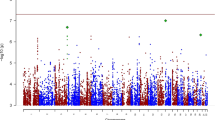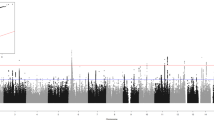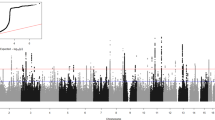Abstract
Panic disorder (PD) and social anxiety disorder (SAD) are moderately heritable anxiety disorders. We analyzed five genes, derived from pharmacological or translational mouse models, in a new case–control study of PD and SAD in European Americans: (1) the serotonin transporter (SLC6A4), (2) the serotonin receptor 1A, (3) catechol-O-methyltransferase, (4) a regulator of g-protein signaling and (5) the gastrin-releasing peptide receptor. Cases were interviewed using the schedule for affective disorders and schizophrenia and were required to have a probable or definite lifetime diagnosis of PD (N=179), SAD (161) or both (140), with first onset by age 31 and a family history of anxiety. Final diagnoses were determined using the best estimate procedure, blind to genotyping data. Controls were obtained from the National Institute of Mental Health Human Genetics Initiative; only subjects above 25 years of age who screened negative for all psychiatric symptoms were included (N=470). A total of 45 single nucleotide polymorphisms were successfully genotyped over the five selected genes using Applied Biosystems SNPlex protocol. SLC6A4 provided strong and consistent evidence of association with the PD and PD+SAD groups, with the most significant association in both groups being at rs140701 (χ2=10.72, P=0.001 with PD and χ2=8.59, P=0.003 in the PD+SAD group). This association remained significant after multiple test correction. Those carrying at least one copy of the haplotype A-A-G constructed from rs3794808, rs140701 and rs4583306 have 1.7 times the odds of PD than those without the haplotype (95% confidence interval: 1.2–2.3). The SAD only group did not provide evidence of association, suggesting a PD-driven association. The findings remained after adjustment for age and sex, and there was no evidence that the association was due to population stratification. The promoter region of the gene, 5-HTTLPR, did not provide any evidence of association, regardless of whether analyzed as a triallelic or biallelic locus, nor did any of the other four candidate genes tested. Our findings suggest that the serotonin transporter gene may play a role in PD; however, the findings require replication. Future studies should attend to the entire genetic region rather than the promoter.
This is a preview of subscription content, access via your institution
Access options
Subscribe to this journal
Receive 12 print issues and online access
$259.00 per year
only $21.58 per issue
Buy this article
- Purchase on Springer Link
- Instant access to full article PDF
Prices may be subject to local taxes which are calculated during checkout


Similar content being viewed by others
References
Kendler KS, Neale MC, Kessler RC, Heath AC, Eaves LJ . The genetic epidemiology of phobias in women. The interrelationship of agoraphobia, social phobia, situational phobia, and simple phobia. Arch Gen Psychiatry 1992; 49: 273–281.
Kendler KS, Neale MC, Kessler RC, Heath AC, Eaves LJ . Major depression and phobias: the genetic and environmental sources of comorbidity. Psychol Med 1993; 23: 361–371.
Weissman MM, Bland RC, Canino GJ, Greenwald S, Lee CK, Newman SC et al. The cross-national epidemiology of social phobia: a preliminary report. Int Clin Psychopharmacol 1996; 11 (Suppl 3): 9–14.
Coelho HF, Cooper PJ, Murray L . A family study of co-morbidity between generalized social phobia and generalized anxiety disorder in a non-clinic sample. J Affect Disord 2007; 100: 103–113.
Fyer AJ . Heritability of social anxiety: a brief review. J Clin Psychiatry 1993; 54 Suppl: 10–12.
Stein MB, Chartier MJ, Hazen AL, Kozak MV, Tancer ME, Lander S et al. A direct-interview family study of generalized social phobia. Am J Psychiatry 1998; 155: 90–97.
Kendler KS, Walters EE, Neale MC, Kessler RC, Heath AC, Eaves LJ . The structure of the genetic and environmental risk factors for six major psychiatric disorders in women. Phobia, generalized anxiety disorder, panic disorder, bulimia, major depression, and alcoholism. Arch Gen Psychiatry 1995; 52: 374–383.
Neale MC, Walters EE, Eaves LJ, Kessler RC, Heath AC, Kendler KS . Genetics of blood-injury fears and phobias: a population-based twin study. Am J Med Genet 1994; 54: 326–334.
Crowe RR, Goedken R, Samuelson S, Wilson R, Nelson J, Noyes Jr R . Genomewide survey of panic disorder. Am J Med Genet 2001; 105: 105–109.
Fyer AJ, Hamilton SP, Durner M, Haghighi F, Heiman GA, Costa R et al. A third-pass genome scan in panic disorder: evidence for multiple susceptibility loci. Biol Psychiatry 2006; 60: 388–401.
Smoller JW, Acierno Jr JS, Rosenbaum JF, Biederman J, Pollack MH, Meminger S et al. Targeted genome screen of panic disorder and anxiety disorder proneness using homology to murine QTL regions. Am J Med Genet 2001; 105: 195–206.
Blum K, Braverman ER, Wu S, Cull JG, Chen TJ, Gill J et al. Association of polymorphisms of dopamine D2 receptor (DRD2), and dopamine transporter (DAT1) genes with schizoid/avoidant behaviors (SAB). Mol Psychiatry 1997; 2: 239–246.
Lochner C, Hemmings S, Seedat S, Kinnear C, Schoeman R, Annerbrink K et al. Genetics and personality traits in patients with social anxiety disorder: a case–control study in South Africa. Eur Neuropsychopharmacol 2007; 17: 321–327.
Kent JM, Coplan JD, Gorman JM . Clinical utility of the selective serotonin reuptake inhibitors in the spectrum of anxiety. Biol Psychiatry 1998; 44: 812–824.
Maron E, Shlik J . Serotonin function in panic disorder: important, but why? Neuropsychopharmacology 2006; 31: 1–11.
Blaya C, Salum GA, Lima MS, Leistner-Segal S, Manfro GG . Lack of association between the serotonin transporter promoter polymorphism (5-HTTLPR) and panic disorder: a systematic review and meta-analysis. Behav Brain Funct 2007; 3: 41.
Hu XZ, Lipsky RH, Zhu G, Akhtar LA, Taubman J, Greenberg BD et al. Serotonin transporter promoter gain-of-function genotypes are linked to obsessive-compulsive disorder. Am J Hum Genet 2006; 78: 815–826.
Richard IH, Schiffer RB, Kurlan R . Anxiety and Parkinson's disease. J Neuropsychiatry Clin Neurosci 1996; 8: 383–392.
Shulman R, Griffiths J, Diewold P . Catechol-O-methyl transferase activity in patients with depressive illness and anxiety states. Br J Psychiatry 1978; 132: 133–138.
Simon NM, Emmanuel N, Ballenger J, Worthington JJ, Kinrys G, Korbly NB et al. Bupropion sustained release for panic disorder. Psychopharmacol Bull 2003; 37: 66–72.
Chen J, Lipska BK, Halim N, Ma QD, Matsumoto M, Melhem S et al. Functional analysis of genetic variation in catechol-O-methyltransferase (COMT): effects on mRNA, protein, and enzyme activity in postmortem human brain. Am J Hum Genet 2004; 75: 807–821.
Lachman HM, Morrow B, Shprintzen R, Veit S, Parsia SS, Faedda G et al. Association of codon 108/158 catechol-O-methyltransferase gene polymorphism with the psychiatric manifestations of velo-cardio-facial syndrome. Am J Med Genet 1996; 67: 468–472.
Ohara K, Nagai M, Suzuki Y, Ochiai M, Ohara K . No association between anxiety disorders and catechol-O-methyltransferase polymorphism. Psychiatry Res 1998; 80: 145–148.
Samochowiec J, Hajduk A, Samochowiec A, Horodnicki J, Stepien G, Grzywacz A et al. Association studies of MAO-A, COMT, and 5-HTT genes polymorphisms in patients with anxiety disorders of the phobic spectrum. Psychiatry Res 2004; 128: 21–26.
Domschke K, Freitag CM, Kuhlenbaumer G, Schirmacher A, Sand P, Nyhuis P et al. Association of the functional V158M catechol-O-methyl-transferase polymorphism with panic disorder in women. Int J Neuropsychopharmacol 2004; 7: 183–188.
Hamilton SP, Fyer AJ, Durner M, Heiman GA, Baisre de Leon A, Hodge SE et al. Further genetic evidence for a panic disorder syndrome mapping to chromosome 13q. Proc Natl Acad Sci USA 2003; 100: 2550–2555.
Rothe C, Koszycki D, Bradwejn J, King N, Deluca V, Tharmalingam S et al. Association of the Val158Met catechol O-methyltransferase genetic polymorphism with panic disorder. Neuropsychopharmacology 2006; 31: 2237–2242.
Woo JM, Yoon KS, Choi YH, Oh KS, Lee YS, Yu BH . The association between panic disorder and the L/L genotype of catechol-O-methyltransferase. J Psychiatr Res 2004; 38: 365–370.
Woo JM, Yoon KS, Yu BH . Catechol O-methyltransferase genetic polymorphism in panic disorder. Am J Psychiatry 2002; 159: 1785–1787.
Domschke K, Deckert J, O'Donovan MC, Glatt SJ . Meta-analysis of COMT vall58met in panic disorder: ethnic heterogeneity and gender specificity. Am J Med Genet B Neuropsychiatr Genet 2007; 144: 667–673.
Meyer-Lindenberg A, Nichols T, Callicott JH, Ding J, Kolachana B, Buckholtz J et al. Impact of complex genetic variation in COMT on human brain function. Mol Psychiatry 2006; 11: 867–877, 797.
Oliveira-Dos-Santos AJ, Matsumoto G, Snow BE, Bai D, Houston FP, Whishaw IQ et al. Regulation of T cell activation, anxiety, and male aggression by RGS2. Proc Natl Acad Sci USA 2000; 97: 12272–12277.
Shumyatsky GP, Tsvetkov E, Malleret G, Vronskaya S, Hatton M, Hampton L et al. Identification of a signaling network in lateral nucleus of amygdala important for inhibiting memory specifically related to learned fear. Cell 2002; 111: 905–918.
Yalcin B, Willis-Owen SA, Fullerton J, Meesaq A, Deacon RM, Rawlins JN et al. Genetic dissection of a behavioral quantitative trait locus shows that Rgs2 modulates anxiety in mice. Nat Genet 2004; 36: 1197–1202.
Leygraf A, Hohoff C, Freitag C, Willis-Owen SA, Krakowitzky P, Fritze J et al. Rgs 2 gene polymorphisms as modulators of anxiety in humans? J Neural Transm 2006; 113: 1921–1925.
Goldstein RB, Weissman MM, Adams PB, Horwath E, Lish JD, Charney D et al. Psychiatric disorders in relatives of probands with panic disorder and/or major depression. Arch Gen Psychiatry 1994; 51: 383–394.
Goldstein RB, Wickramaratne PJ, Horwath E, Weissman MM . Familial aggregation and phenomenology of ‘early’-onset (at or before age 20 years) panic disorder. Arch Gen Psychiatry 1997; 54: 271–278.
Talati A, Ponniah K, Strug LJ, Hodge SE, Fyer AJ, Weissman MM . Panic disorder, social anxiety disorder, and a possible medical syndrome previously linked to chromosome 13. Biol Psychiatry 2007; 63: 594–601.
Weissman MM . Family genetic studies of panic disorder. J Psychiatr Res 1993; 27 (Suppl 1): 69–78.
Fyer A, Endicott J, Mannuzza S, Klein DF . Schedule for Affective Disorders and Schizophrenia-lLifetime version, Modified for the Study of Anxiety Disorders (SADS-LA). Anxiety Disorders Clinic, New York State Psychiatric Institute: New York, NY, 1985.
Weissman MM, Wickramaratne P, Adams P, Wolk S, Verdeli H, Olfson M . Brief screening for family psychiatric history: the family history screen. Arch Gen Psychiatry 2000; 57: 675–682.
Leckman JF, Sholomskas D, Thompson WD, Belanger A, Weissman MM . Best estimate of lifetime psychiatric diagnosis: a methodological study. Arch Gen Psychiatry 1982; 39: 879–883.
Walters E, Kessler RC, Nelson CB, Mroczek DC . Scoring the World Health Organization's Composite International Diagnostic Interview Short Form (CIDI-SF); World Health Organization, Geneva, revised December 2002.
Talati A, Fyer AJ, Weissman MM . A Comparision between NIMH screened an clinically interviewed control samples on neuroticism and extraversion. Mol Psychiatry 2008; 13: 122–130.
Tobler AR, Short S, Andersen MR, Paner TM, Briggs JC, Lambert SM et al. The SNPlex genotyping system: a flexible and scalable platform for SNP genotyping. J Biomol Tech 2005; 16: 398–406.
Barrett JC, Fry B, Maller J, Daly MJ . Haploview: analysis and visualization of LD and haplotype maps. Bioinformatics 2005; 21: 263–265.
Yonan AL, Palmer AA, Gilliam TC . Hardy–Weinberg disequilibrium identified genotyping error of the serotonin transporter (SLC6A4) promoter polymorphism. Psychiatr Genet 2006; 16: 31–34.
Stephens M, Smith N, Donnelly P . A new statistical method for haplotype reconstruction from population data. Am J Hum Genet 2001; 68: 978–989.
Rosenberg NA, Li LM, Ward R, Pritchard JK . Informativeness of genetic markers for inference of ancestry. Am J Hum Genet 2003; 73: 1402–1422.
Akey JM, Zhang G, Zhang K, Shriver MD . Interrogating a high-density SNP map for signatures of natural selection. Genome Res 2002; 12: 1805–1814.
Pritchard JK, Stephens M, Donnelly P . Inference of population structure using multilocus genotype data. Genetics 2000; 155: 945–959.
Gorroochurn P, Hodge SE, Heiman G, Greenberg DA . Effect of population stratification on case–control association studies. II. False-positive rates and their limiting behavior as number of subpopulations increases. Hum Hered 2004; 58: 40–48.
Gorroochurn P, Hodge SE, Heiman GA, Greenberg DA . A unified approach for quantifying, testing and correcting population stratification in case–control association studies. Hum Hered 2007; 64: 149–159.
Sladek R, Rocheleau G, Rung J, Dina C, Shen L, Serre D et al. A genome-wide association study identifies novel risk loci for type 2 diabetes. Nature 2007; 445: 881–885.
Lesch KP, Gutknecht L . Pharmacogenetics of the serotonin transporter. Prog Neuropsychopharmacol Biol Psychiatry 2005; 29: 1062–1073.
Holmes A, Murphy DL, Crawley JN . Reduced aggression in mice lacking the serotonin transporter. Psychopharmacology (Berl) 2002; 161: 160–167.
Martin J, Cleak J, Willis-Owen SA, Flint J, Shifman S . Mapping regulatory variants for the serotonin transporter gene based on allelic expression imbalance. Mol Psychiatry 2007; 12: 881.
Hettema JM, Neale MC, Kendler KS . A review and meta-analysis of the genetic epidemiology of anxiety disorders. Am J Psychiatry 2001; 158: 1568–1578.
Battaglia M, Bertella S, Politi E, Bernardeschi L, Perna G, Gabriele A et al. Age at onset of panic disorder: influence of familial liability to the disease and of childhood separation anxiety disorder. Am J Psychiatry 1995; 152: 1362–1364.
Acknowledgements
This research was supported by a clinical studies project (Myrna M Weissman, PI) of NIMH Program Project NIMH PO1 MH60970-04 (Rene Hen, PI). We acknowledge the support of MH-48858 (Susan E Hodge, PI) and HG004314 (Lisa J Strug, PI). The NIMH sample was collected by ‘Molecular Genetics of Schizophrenia II’ collaboration, and included the following investigators: ENH/Northwestern University, Evanston, IL, MH059571—Pablo V Gejman, MD (Collaboration coordinator; PI), Alan R Sanders, MD; Emory University School of Medicine, Atlanta, GA, MH59587—Farooq Amin, MD (PI); Louisiana State University Health Sciences Center; New Orleans, LA, MH067257—Nancy Buccola APRN, BC, MSN (PI); University of California-Irvine, Irvine, CA, MH60870—William Byerley, MD (PI); Washington University, St Louis, MO, U01, MH060879—C Robert Cloninger, MD (PI); University of Iowa, Iowa, IA, MH59566—Raymond Crowe, MD (PI), Donald Black, MD; University of Colorado, Denver, CO, MH059565—Robert Freedman, MD (PI); University of Pennsylvania, Philadelphia, PA, MH061675—Douglas Levinson, MD (PI); University of Queensland, QLD, Australia, MH059588—Bryan Mowry, MD (PI); Mt Sinai School of Medicine, New York, NY, MH59586—Jeremy Silverman, PhD (PI).
Author information
Authors and Affiliations
Corresponding author
Rights and permissions
About this article
Cite this article
Strug, L., Suresh, R., Fyer, A. et al. Panic disorder is associated with the serotonin transporter gene (SLC6A4) but not the promoter region (5-HTTLPR). Mol Psychiatry 15, 166–176 (2010). https://doi.org/10.1038/mp.2008.79
Received:
Revised:
Accepted:
Published:
Issue Date:
DOI: https://doi.org/10.1038/mp.2008.79
Keywords
This article is cited by
-
The association between serotonin-related gene polymorphisms and susceptibility and early sertraline response in patients with panic disorder
BMC Psychiatry (2020)
-
Pediatric Migraine and Academics
Current Pain and Headache Reports (2020)
-
Candidate genes in panic disorder: meta-analyses of 23 common variants in major anxiogenic pathways
Molecular Psychiatry (2016)
-
Influence of 5-HTT variation, childhood trauma and self-efficacy on anxiety traits: a gene-environment-coping interaction study
Journal of Neural Transmission (2016)
-
Acid–base dysregulation and chemosensory mechanisms in panic disorder: a translational update
Translational Psychiatry (2015)



